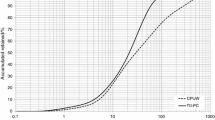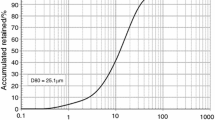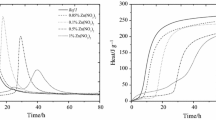Abstract
Two catalyst wastes (RNi and RAI) from polyol production were considered as hazardous, due to their respective high concentration of nickel and aluminum contents. This article presents the study, done to avoid environmental impacts, of the simultaneous solidification/stabilization of both catalyst wastes with type II Portland cement (CP) by non-conventional differential thermal analysis (NCDTA). This technique allows one to monitor the initial stages of cement hydration to evaluate the accelerating and/or retarding effects on the process due to the presence of the wastes and to identify the steps where the changes occur. Pastes with water/cement ratio equal to 0.5 were prepared, into which different amounts of each waste were added. NCDTA has the same basic principle of Differential Thermal Analysis (DTA), but differs in the fact that there is no external heating or cooling system as in the case of DTA. The thermal effects of the cement paste hydration with and without waste presence were evaluated from the energy released during the process in real time by acquiring the temperature data of the sample and reference using thermistors with 0.03 °C resolution, coupled to an analog–digital interface. In the early stages of cement hydration retarding and accelerating effects occur, respectively due to RNi and RAl presence, with significant thermal effects. During the simultaneous use of the two waste catalysts for their stabilization process by solidification in cement, there is a synergic resulting effect, which allows better hydration operating conditions than when each waste is solidified separately. Thermogravimetric (TG) and derivative thermogravimetric analysis (DTG) of 4 and 24 h pastes allow a quantitative information about the main cement hydrated phases and confirm the same accelerating or retarding effects due to the presence of wastes indicated from respective NCDTA curves.
















Similar content being viewed by others
References
Chen QY, Tyrer M, Hills CD, Yang XM, Carey P. Immobilization of heavy metal in cement-based solidification/stabilization—a review. Waste Manag. 2009;29:390–403.
Cioffi R, Lavorgna M, Santoro L. Environmental and technological effectiveness of a process for the stabilization of a galvanic sludge. J Hazard Mater. 2002;89:165–75.
Kindness A, Lachowski EE, Minocha AK, Glasser FP. Immobilisation and fixation of molybdenum (VI) by Portland cement. Waste Manag. 1994;14:97–102.
Minocha AK, Jain N, Verma CL. Effect inorganic materials on solidification of heavy metal sludge. Cem Concr Res. 2003;33:1695–701.
Dweck J, Buchler PM, Coelho ACV. Solidification/stabilization of a tannery waste with blended cement and wyoming bentonite. J Environ Sci Health. 2000;35:715–40.
Lin CK, Chen JN, An Lin CC, MR N. XRD and EDS study of solidification/stabilization of chromium with Portland cement and C3S. J Hazard Mater. 1997;56:21–34.
Shi C, Spence R. Designing of cement-based formula for solidification/stabilization of hazardous, radioactive, and mixed wastes. Crit Rev Environ Sci Technol. 2004;34:391–417.
Dweck J, Buchler PM, Coelho ACV, Cartledge FK. Hydration of a Portland cement blended with calcium carbonate. Thermochim Acta. 2000;346:105–13.
Winnefeld F, Barlag S. Calorimetric and thermogravimetric study on the influence of calcium sulfate on the hydration of ye’elimite. J Therm Anal Calorim. 2010;101:949–57.
Vespa MR, Dahn R, Grolimund D, Harfouche M, Wieland E, Scheidegger AM. Speciation of heavy metals in cement-stabilized waste forms: a micro-spectroscopic study. J Geochem Explor. 2006;88:77–80.
Lange LC, Hills CD, Poole AB. The effect of accelerated carbonation on the properties of cement solidified waste forms. Waste Manag. 1996;16:757–63.
Salhan A, Billinghan J, King AC. The effect of a retarder on the early stages of the hydration of tricalcium silicate. J Eng Math. 2003;3–4:367–77.
Poon CS, Peters DJ, Perry R, Barnes P, Barker AP. Mechanisms of metal stabilization in cement based fixation processes. Sci Total Environ. 1985;41:55–71.
Poon CS, Clark AI, Perry R. Permeability study of the cement based solidification process for the disposal of hazardous wastes. Cem Concr Res. 1986;16:161–72.
Brandštetr J, Polcer J, Krátký J, Rolešinský R, Havlica J. Possibilities of the use of isoperibolic calorimetry for assessing the hydration behavior of cementitious systems. Cem Concr Res. 2001;31:941–7.
Wczelik WN. Calorimetry in the studies of cement–Pb compounds interaction. J Therm Anal Calorim. 2007;88:291–4.
Ježo L, Palou M, Kozánková J, Ifka T. Determination of activation effect of Ca(OH)2 upon the hydration of BFS and related heat by isothermal calorimeter. J Therm Anal Calorim. 2010;101:585–93.
Cunha ALC, Gonçalvez JP, Cartledge FK, Filho RDT, Dweck J. Evaluation of the metakaolin pozzolanic reactivity in cement pastes. Mater Sci Forum. 2008;591–593:827–32.
Gawlicki M, Wczelic WN, Bak L. Calorimetry in the studies of cement hydration: setting and hardening of Portland cement–calcium aluminate cement mixtures. J Therm Anal Calorim. 2010;100:571–6.
Pacewska B, Wilińska I, Blonkowski G. Investigation of cement early hydration in the presence of chemically activated fly ash: use of calorimetry and infrared absorption methods. J Therm Anal Calorim. 2008;93:769–76.
Lou W, Guan B, Wu Z. Calorimetric study of ternary binder of calcium aluminate cement, Portland-limestone cement and FGD gypsum. J Therm Anal Calorim. 2010;101:119–27.
Kadri EH, Duval R. Hydration heat kinetics of concrete with silica fume. Constr Build Mater. 2009;23:3388–92.
Cheren da Cunha AL, Gonçalves JP, Büchler PM, Dweck J. Effect of metakaolin pozzolanic activity in the early stages of cement type II paste and mortar hydration. J Therm Anal Calorim. 2008;92:115–9.
Pinto CA, Dweck J, Sansalone JJ, Cartledge FK, Tittlebaum ME, Büchler PM. Early stages of solidification/stabilization of storm water runoff solid residuals in cement. J Therm Anal Calorim. 2005;80:715–20.
Technical Standards of Brazilian Association (ABNT), NBR 10.004. Solid waste—classification. 2004 (in Portuguese).
Dweck J, Buchler PM, Aderne RS, Silva PFF, Coelho ACV, Cartledge FK. Evaluation cement hydration by non-conventional DTA: an application to waste solidification. J Therm Anal Calorim. 2003;71:821–7.
Glasser FB. Fundamental aspects of cement solidification and stabilization. J Hazard Mater. 1997;52:151–70.
Alberoni VG. Solidification/stabilization process of an industrial waste containing nickel. M.Sc. Dissertation, School of Chemistry, Rio de Janeiro University. 2005:1–98 (in Portuguese).
Silva DM. Solidification/stabilization process of an industrial waste containing aluminum. M.Sc. Dissertation, School of Chemistry, Rio de Janeiro University. 2005:1–99 (in Portuguese).
Technical Standards of Brazilian Association (ABNT), NBR 10.005. Leaching of solid residues—procedure. 2004 (in Portuguese).
Environmental Protection Authority (EPA). Environmental guidelines: assessment, classification and management of liquid and non-liquid wastes (ISBN 0 7313 0215 X, EPA 99/21). Australia: Sydney; 1999.
Pinto CA, Buchler PM, Dweck J. Pozzolanic properties of a residual FCC catalyst during the early stages of cement hydration. J Therm Anal Calorim. 2007;87:715–20.
Krielow E. A screening assessment of solidification/stabilization for storm water residuals. M.Sc. Thesis, Graduate Faculty of the Louisiana State University and Agriculture and Mechanical College, 2003:1–202.
Scheidegger AM, Wieland E, Dahn R, Spieler P. Spectroscopic evidence for the formation of layered Ni–Al double hydroxides in cement. Environ Sci Technol. 2000;34:4545–8.
Scheidegger AM, Wieland E, Scheinost AC, Dahn R, Tits J, Spieler P. Ni phases formed in cement and cement systems under highly alkaline conditions: an XAFS study. J Synchrotron Radiat. 2001;8:916–8.
Pinto CA, Hamassaki LT, Diaz FRV, Dweck J, Buchler PM. Tannery waste solidification and stabilization. J Therm Anal Calorim. 2004;77:777–87.
Dweck J, Cherem da Cunha AL, Pinto CA, Gonçalves JP, Büchler PM. Thermogravimetry on calcined mass basis: hydrated cement phases and pozzolanic activity quantitative analysis. J Therm Anal Calorim. 2009;97:85–9.
Acknowledgements
This study was performed with the financial support of the Brazilian National Research Council (CNPQ), Brazilian Ministry of Education (CAPES), and São Paulo State Research Foundation (FAPESP).
Author information
Authors and Affiliations
Corresponding author
Rights and permissions
About this article
Cite this article
Melchert, M.B.M., Viana, M.M., Lemos, M.S. et al. Simultaneous solidification of two catalyst wastes and their effect on the early stages of cement hydration. J Therm Anal Calorim 105, 625–633 (2011). https://doi.org/10.1007/s10973-011-1330-2
Published:
Issue Date:
DOI: https://doi.org/10.1007/s10973-011-1330-2




